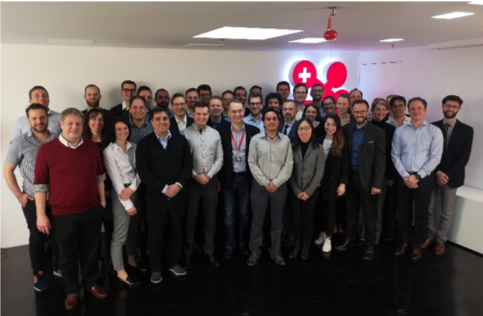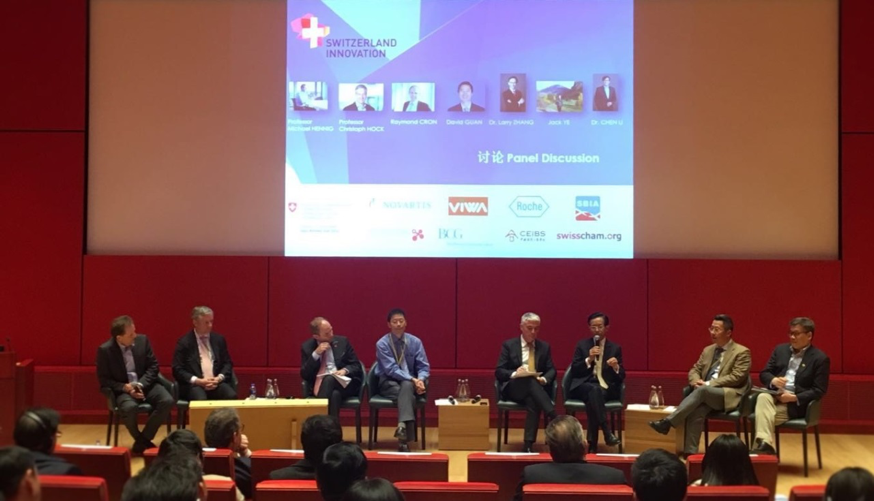By Percy Chen, Junior Project Manager Art-Science
On 16 April 2020, we hosted our webinar titled Café des Sciences: Qubits and Entanglement. Two renowned Swiss quantum field experts Prof. Dr. Richard J. Warburton, Director of NCCR SPIN Project and Professor of Experimental Physics at University of Basel provided us with a technical introduction to quantum computing, while Mr. Franck Franchin, President of Swiss Quantum Hub, illustrated for us the support for Swiss quantum startups. This edition of Café des Sciences was organized in collaboration with the Section of Science, Technology and Education at the Embassy of Switzerland in China.
Prof. Dr. Richard J. Warburton (left) and Moderator Dr. Gaetan Messin, Attaché for Science and Technology, Consulate General of France in Shanghai (right).
Despite some technical issues, we trust that everyone has acquired informative insights on the topic. Due to the time constraint, we could only present a limited number of questions. If you have further questions for our speakers regarding quantum computing, please email us at cafedessciences@swissnexchina.org. We will try our best to forward them to the speakers.
The edited webinar recording is available to view here (until May 15, 2020).
_______________
Here are some key takeaways that we would like to share with you.
From Prof. Dr. Richard J. Warburton’s speech:
A bit is a basic unit of information. In information theory, one bit is typically defined as the information entropy of a binary random variable that is 0 or 1 with equal probability. Normally, it is like a classic switch - either on or off. A quantum qubit is different in the sense that it can be on and off simultaneously. And this ability of a quantum system to be in multiple states at the same time is called Superposition.
Quantum Entanglement comes into play when we attach another pair of switches to qubits. Both switches can be on or off at the same time. The quantum state of each switch of the pair cannot be described independently of the state of the others, even when the particles are separated by a large distance. Vice versa, when one switch is measured, its paired switch is immediately determined.
So now why is quantum computing so difficult to understand? This is because it is very hard to separate quantum systems from the environment, which is the rest of our world. One significant problem is that things turn to decay. If you put a quantum qubit in the “on” state, it will gradually lose energy and turn to the “off” state. In other words, maintaining a phrase of a quantum state is very difficult.
The goal of this century is to make quantum physics useful.
The no-cloning theorem states that it is impossible to create an identical copy of an arbitrary unknown quantum state.
Quantum Computer: most powerful computer allowed by the laws of physics. It is capable of solving hard problems in chemistry, material science, physics, micro-biology, and more.
Quantum computer uses qubtis - superpositions of 0 and - and its computational power comes from entanglement between qubits.
The current status is that few qubit devices exist and although quantum supremacy is close, a completed quantum computer is not. This is because we are never able to fully separate a quantum system from its environment. We would need 100 million physical qubits if we want to simulate the behavior of a complex molecule. This scalability problem is extremely challenging.
In traditional computer, the scaliability problem has been solved. Silicon transistors now have FinFET technology with less than 10 nano meters of element.
The NCCR SPIN aims to make a major contribution to research and the development of quantum computers and create the basis for a new information-processing technology. The NCCR’s objective is to develop small, fast, scalable silicon-based qubits. It will also generate important findings on software and algorithm development, error correction and the architecture of future quantum computers.
Professor Richard J. Warburton and his team are pinning their hopes on silicon, a semiconductor that has been a proven material in the industry for decades. They are convinced that silicon technology is highly promising in enabling the on-chip integration of billions of components, leading to a particularly strong quantum computer.
From Mr. Franck Franchin’s presentation:
Swiss Quantum Hub is a non-profit think tank with the mission to help quantum startups accelerate and scale up. The community has around 5,000 members in Switzerland, France, Germany and U.S. Right now, there are four services - Swiss Quantum Academy (SQA), Swiss Quantum Garage (SQG), Swiss Quantum Investor Club (SQIC), and Swiss Quantum MarketPlace (SQMP). Its strategic partnerships include Quantonation, Atos, Amazon AWS, and BNP Paribas.
There are 5 big sectors for the quantum industry: Deep Physics, Quantum Sensing, Quantum Computing, and Quantum Cybersecurity.
Quantum computers are not faster than conventional computers at all tasks.
Constructing a quantum computer which is capable of outperforming classical computers is a formidable task. One of the most important issues is error correction: we need thousands of physical qubits to achieve one logical fault.
Quantum Computers bring new capabilities that existing computers do not have into fields such as in Natural Language Processing and Molecular Simulations.
Many problems in Finance, for example, can be expressed as optimization and prediction problems, like finding which asset should be included in a portfolio or estimating of the risk and the return of a portfolio problem. These types of problems are particularly hard for classical computers but find a natural formulation using quantum algorithms.
At the end, we would like to express our great appreciation to Prof. Dr. Richard J. Warburton and Mr. Franck Franchin for sharing their valuable expert insights. We would also like to thank our community for your great engagement as always! Please stay tuned for our next event!
Dr. Gaetan Messin, Attaché for Science and Technology, Consulate General of France in Shanghai (left) and Cissy Sun, Head of Art-Science at swissnex China (right).































































